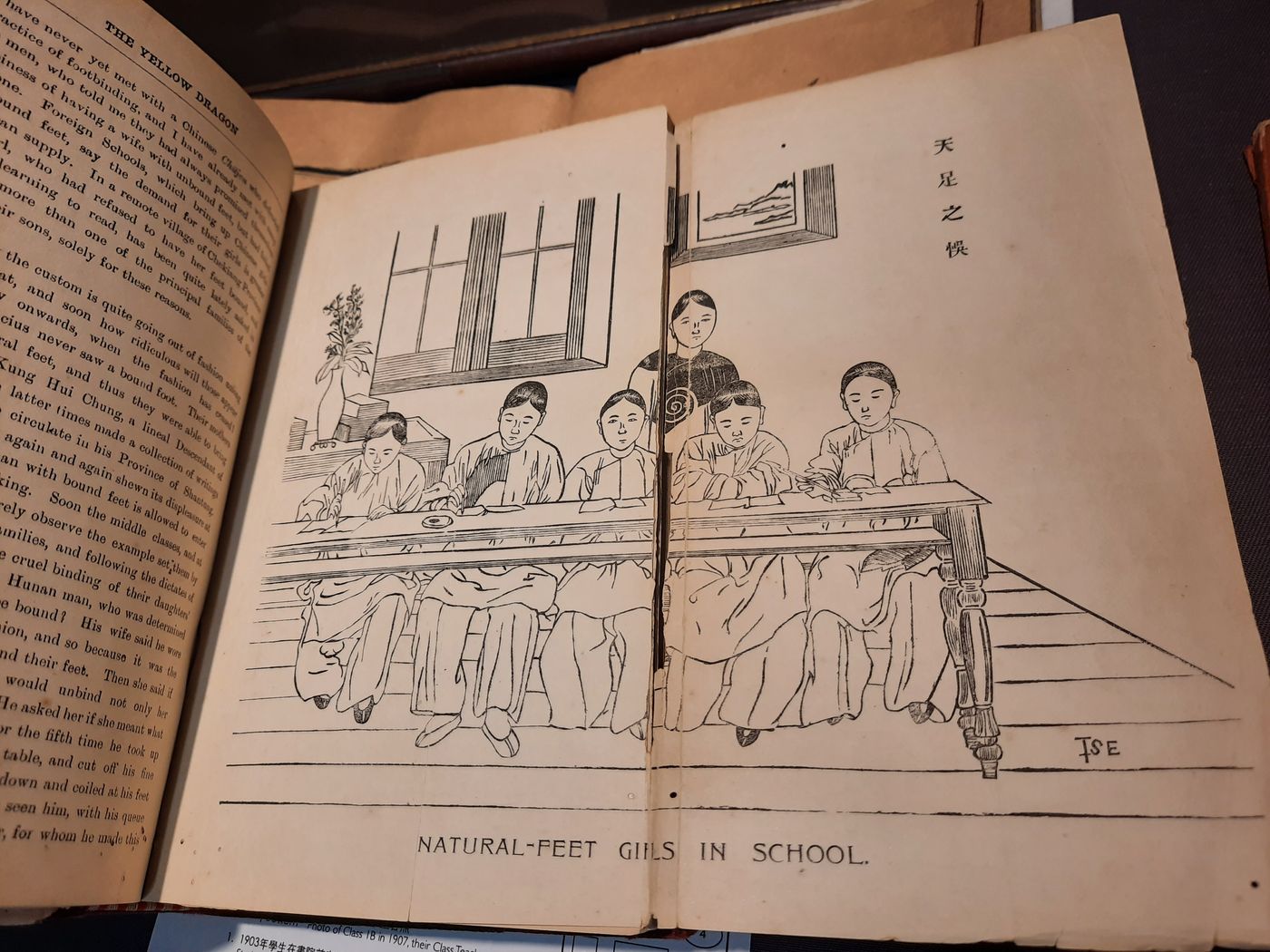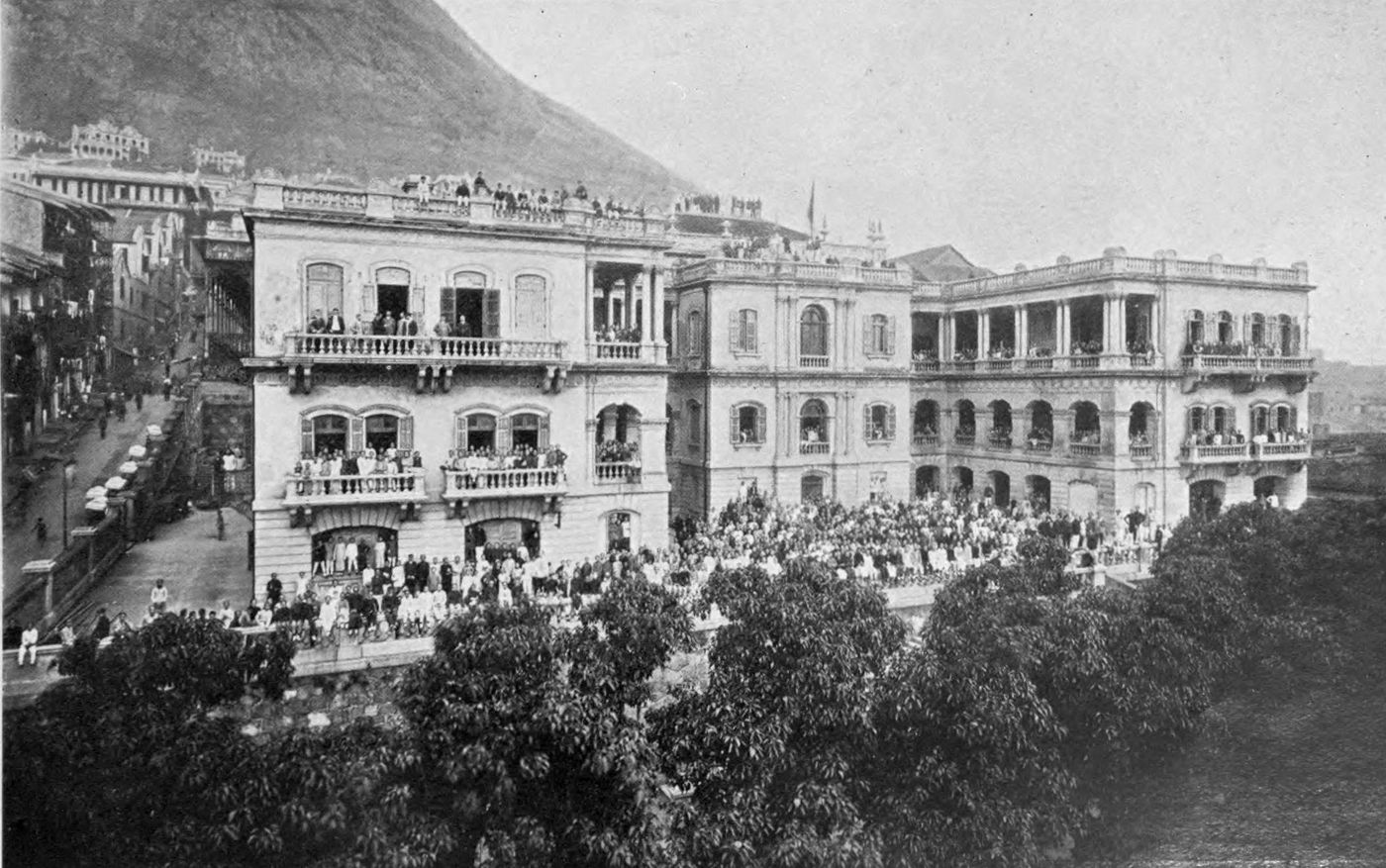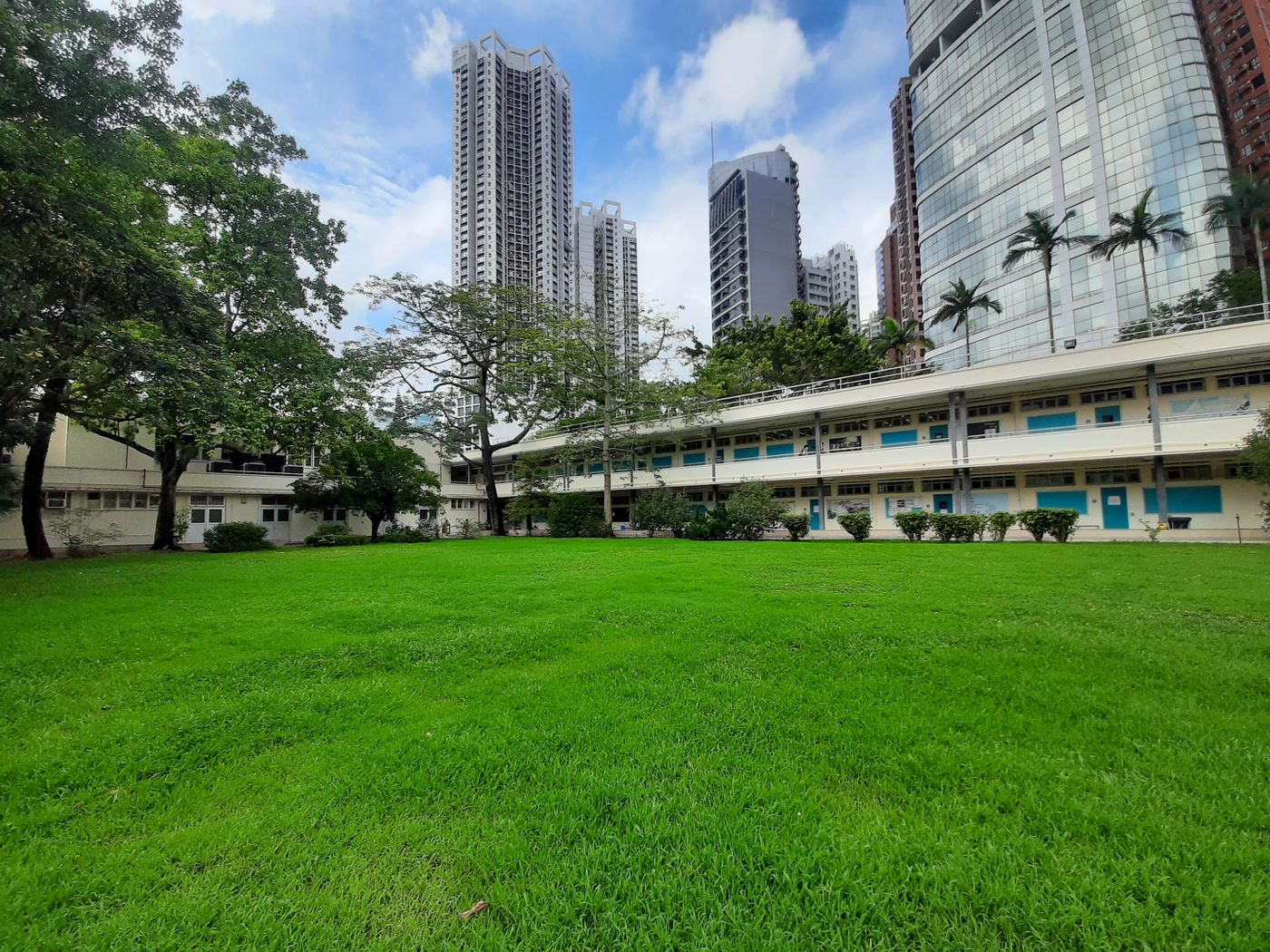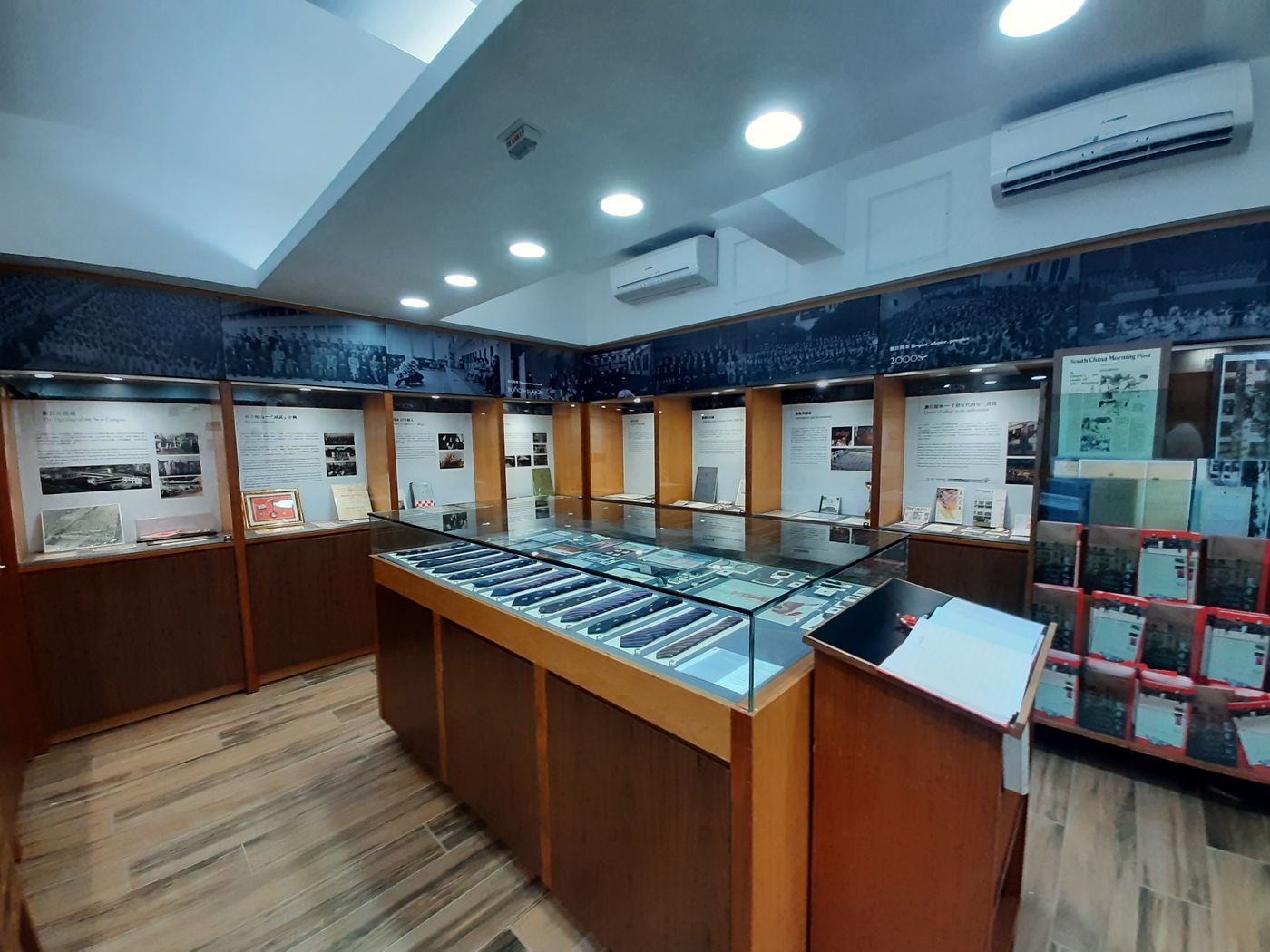Visiting the History Museum of the Imperial College of Renfeng

On the Sanyikou of King's Road, Causeway Road and Causeway Bay Road, stands the Queen's College, the oldest government school in Hong Kong. Under normal circumstances, the campus is only open to new students. Little-known is that there is a museum on the campus, the Royal Renfeng School History Museum, which displays all the 160-year-old school history, which has been handed down by the school to this day, as well as donated and lent by alumni and collectors. The cultural relics unearthed also reflect the educational and social changes in Hong Kong over the past century.

A postwar campus built on a swamp
Coming to the third-generation campus of Queen's College in Causeway Bay, the most personal experience is that mosquitoes are almost everywhere, especially in summer. The school building is only two stories high and has a lush green lawn, but compared with the school building in Central before the war, the level of "luxury" is not comparable. On the school history gallery of the present Queen's College, there are deconstructed pictures of the school buildings of the emperor's past dynasties. We can see that at the beginning of the school's establishment in 1862, the school building on Gough Street in Central is small but has an elegant architectural style of the Victorian era. In 1884, it moved to the second-generation school building at the junction of Aberdeen Street and Hollywood Road (that is, the current location of PMQ). The silver is 250,000 Hong Kong dollars. It is a neoclassical building and was built with the help of prisoners in Victoria Prison. It is a pity that this luxurious school building was destroyed during World War II after more than 50 years of use. The only surviving object is the marble head of the former principal, Dr GH Bateson Wright, but it is also "scarred" and is now placed on the Causeway Bay campus. at the entrance.
The second-generation school building before the war was destroyed by the war. After the war, the Queen's College once borrowed 26 MacDonnell Road for a short time and shared a school building with Clementi Secondary School. It was not until 1949 that the government decided to build a new school building at the Queen's Stadium on Causeway Road, Causeway Bay. After the war, materials were scarce in Hong Kong, and it was impossible to rebuild a school like before. All buildings were mainly practical and functional. The reason for the selection of the site in Causeway Bay is probably that the center of Victoria City was saturated at that time, and it was also busy with post-war reconstruction. The foundation stone for the new school building was laid on May 22, 1950. It was designed by John Charter of the Public Works Bureau and built by Lai Kee. Because Causeway Bay used to be a low-lying area, even after it was filled, the foundation of the school building was higher than the adjacent sports ground in order to prevent flooding.

The new school building is only two-storey high, which is quite "skin-saving" compared with the previous school building. There is no piling, so it was completed within 21 weeks and opened on September 22 of the same year. The area around Causeway Road was originally a swamp. Even though it has been filled for many years, the innate "terroir" is difficult to change. This probably explains the reason for the mosquito infestation on the campus, and it has also been preserved for the emperor for many years. The cultural relics that come down have a certain degree of influence.
The school history museum supplements the history of the school
In addition to the school history gallery, Queen's College also has a school history museum. In 2012, Huangren celebrated its 150th anniversary and held an exhibition in the Central Library. In 2017, it held another school history exhibition. The two exhibitions collected a lot of things donated by old students, and the school also found many ancient archives. Therefore, the most urgent problem faced by teachers, students and old students at that time was to find a proper place to store the cultural relics.
Yu Shangxian, a former student of Emperor Ren and now the honorary curator of the Imperial College Renfeng School History Museum, pointed out: "Before 2017, we put our things in a room on the ground, and that room had a lot of shortcomings. When it rained, it would flood because it was always low-lying. In the area, snakes, insects, rats, ants, frogs and spiders once entered the room and damaged the cultural relics. So in 2017, we decided to move the cultural relics to the second floor, and also set up a team of student ambassadors to help handle the cultural relics and lead guided tours. ”
As a government school, the cultural relics that can be preserved are more complete than many other schools or institutions. Most documents can also be found on campus as long as they are not submitted to other government departments, but the status of the items is another matter. "At that time, some documents were placed in the principal's office, and some were placed in a dark corner of the lobby. There were corpses and eggs of insects on the objects. It took a lot of time to sweep away the eggs one by one. Sweeping; plus the former government archives, I like to use a green rope with metal at both ends to nail the documents together. Those nails will rust; and there are 4-digit clips, all of which are also iron, and if you use a needle earlier, they will rust. Rust. When we uncover the documents, we have to remove all these things. Because I have interned in a museum before, I can do these simple cultural relics processing work, but some more complicated ones, such as ironing the crumpled paper, Or to restore the color, you have to ask outside professionals to help.”
Thanks to the efforts of both former and current students, the Museum of Royal Humanities currently has about 3 to 4,000 items in the collection, including photos, documents, certificates, and trophies.

The ladder of learning English and Western learning social advancement
As the oldest official school in Hong Kong, the changes that Huangren has experienced together with Hong Kong society can also be found in the school history museum. At the beginning of the school, it was called Central Academy, also known as Central University, Central University, etc. It was renamed Queen's College in 1894. The school newspaper, student works and certificates in the library can be seen from different eras. Jen's name.
Although the exhibits in the museum are mostly post-war objects, the pre-war emperor can also see his important role in early Hong Kong education in the explanatory pictures and some precious pre-war cultural relics. For example, in the early group photo of teachers and students, it can be seen that the "shape" of the students is very different from that of modern students. Not only are they still wearing long shirts with braids, but some students in the same class are obviously more mature and some are smaller. This reflects the interesting phenomenon of the admission of the Central Academy in the early days. According to a report in 1870 cited in the book "Queens's College: Its History 1862-1987", almost all the students in the early days of the school were married men, and their ages varied. Therefore, the school pursues mixed-age teaching, and sometimes father and son are in the same class.
In the early colonial era, the Hong Kong government did not pay much attention to the education of the people, and Western-style schools were usually run by churches. Later, out of the needs of the times and society, the government limited the number of schools. In Hong Kong, which is located in the southern border of the Qing Empire, it was not easy for scholars to stand out in the national imperial examinations. Therefore, many Hong Kong people enrolled in these newly opened Western-style schools at that time, hoping to learn English well, in this new world in the colony. Under this background, the Central Academy was born in 1862, and imitated the British academic system. In 1865, English was listed as a compulsory subject, and there were also algebra, arithmetic, chemistry, silent writing, mathematics, geography, geometry, grammar, measurement, etc.
The blueprint for these courses is from the UK, but they are very popular among Chinese circles, especially middle-class Chinese children. In fact, they are the only ones who have sufficient financial ability and understand the importance of English in the workplace. According to the "Circular Daily" on March 4, 1881, "On the second day of the second lunar month (the second month of the old calendar), the National Academy of Sciences in Hong Kong opened its hall, and there were more than 400 students and students who signed up for admission, and there were almost no empty seats. , this also sees the multitude of those who wish to learn English.”
Learning English well and finding a good job is the purpose of most people who enter the Central Academy. Before the establishment of the University of Hong Kong, as long as you hold a "School Leaving Certificate" issued by Central College/Queen's College, you will be accepted basically without an interview. Many of these ancient "school leaving certificates" are currently on display in the school history museum. Yu Shangxian pointed out: "The original school leaving certificate did not have a photo, and it was easy to be forged or even faked. As more and more people were deceived, the school began to add photos and seals to the certificate, which can be said to be the earliest anti-counterfeiting technology. "
During the Meiji Restoration period, Japanese students were attracted to study
Some of these group photos have names written on them, and some of them even have Japanese surnames. It turned out that the Central Academy began to accept foreign students in 1867, one year before the Meiji Restoration in Japan. After Japan ended its lock-down and reopened to the outside world, Hong Kong was often the first port of call for Japanese envoys to visit abroad, and the westernization of Hong Kong became a model for Japan to follow. At the beginning of the Central Academy, there were already Japanese students studying there, and most of them were estimated to be learning foreign languages and Western knowledge.
The Hong Kong Daily Press on February 13, 1871 reported that a student surnamed Kurogo (Queen of the Black) had achieved excellent results in the Central Academy; then there was T. Namiki (Namiki or Namiki), who was studying in Europe. He was awarded the book "Cabinet of Gems" for his excellent grades in the Chinese class offered by him. There is also An Hiro Banichiro, a native of Fukuoka Prefecture, Japan, who entered the Central Academy to study English in 1878, graduated in 1880, went to Cambridge University to study law in 1885, and later became the president of the Manchurian Railway. In 1887, the Japanese Ministry of Foreign Affairs dispatched Odakiri Manjusuke, Yamazaki Kamizaki, Okawa Hirata, and Toshima Sasatsu to study English and Cantonese at the Central Academy. It can be seen that in the modernization process of Japan, the Queen's College and even the whole of Hong Kong also have a certain role.
The unmissable treasures of the school history museum
The current school history museum cannot display all the cultural relics, but many pictures and exhibits have also been uploaded to the school history museum's website for free browsing. If you have the opportunity to visit the school history museum, Yu Shangxian, who has curated exhibitions for the school history museum, will recommend some of the must-see collections, including the "Huanglong News".
"The Yellow Dragon Newspaper was founded in June 1899. It is the oldest bilingual school journal in Hong Kong, or a magazine. It is still published on time. Although we have donated the entire set to the Central Library, there is still a Ben's oldest stays at school."
Interestingly, the name of Huanglongming school newspaper is quite nationalistic, but it was born in the heyday of the development of British imperialism. According to his observation, the early "Huang Long Bao", as a publication of an elite colonial institution, reflected the strong pro-British tendencies of the Queen's College. few. But at the same time, the publication also emphasizes that "all the world are brothers", which is a vision of embracing a pluralistic society.
As for the post-war cultural relics, Yu Shangxian mentioned that in the exhibition cabinet barrel of the school history museum (a display device that the audience can open and explore on their own), there is a sports shirt before 1997 with a crown school badge.
"Students often miss things at school. This sports shirt is one of them, but the janitor didn't throw it away. The fabric used to be very good, and the janitor used to wipe the blackboard for 20 years. That one The shirt is already riddled with holes, but since 1997, things with crowns are no longer used, so this shirt is also very precious."
If you pay attention, in fact, the school badge of the Central Academy at the beginning of the school did not have a crown. Yu Shangxian explained: "In the beginning, there was no crown. Because it was a government school, it was only used the government's coat of arms at first, but after World War II, because there were more government schools, there were school badges to identify different schools. Therefore, it was only in 1947. There was the first official school badge, and there was no crown at that time. But what's more interesting is that there was actually more than one school badge at that time. There were three different school badges on the school jacket, the white shirt and the school gate. The chapter has a crown, and the one hanging in front of the school from 1950 to the present has no crown.”
The History of King's University will also change every year, and those who are interested in participating can apply online to make an appointment to visit. Its website also has a wealth of historical pictures and archives for readers to peruse.
Royal Renfeng School History Museum website: https://www.qc1862.org/
Published in Causeway Bay Penguins , August 16, 2022
Subscribe to Sponsorship: https://liker.land/learnedfriend/civic
Like my work? Don't forget to support and clap, let me know that you are with me on the road of creation. Keep this enthusiasm together!



- Author
- More